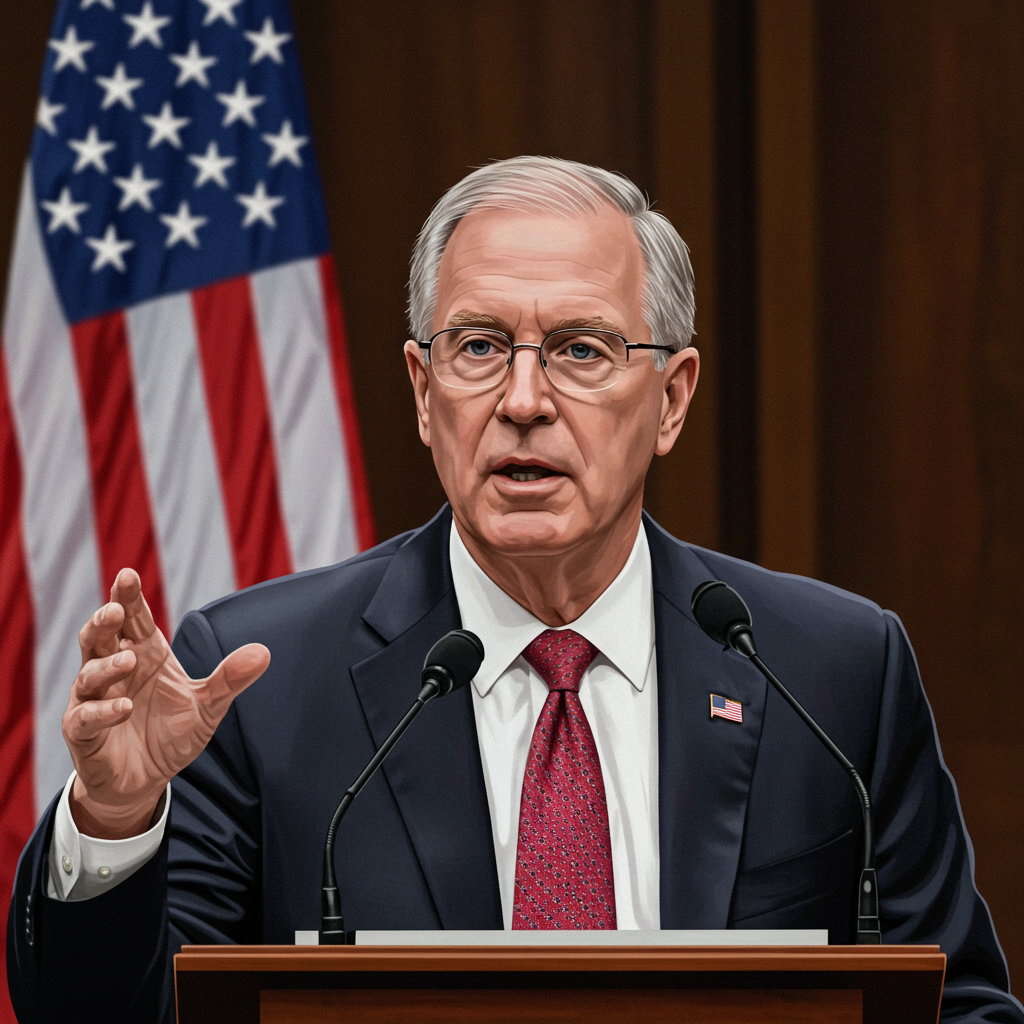The fate of president trump’s ambitious domestic policy agenda hangs in the balance as his signature “megabill” heads for a crucial vote in the U.S. house of Representatives. After narrowly clearing the Senate in a tense overnight session, the comprehensive legislation, targeting everything from tax policy and the federal safety net to border security, faces significant opposition from within the Republican party’s own ranks. Speaker Mike Johnson and the White House are locked in intense negotiations, working frantically to unite a fractured GOP conference and secure enough votes to pass the bill before a self-imposed July 4th deadline, a challenge made steeper by the Senate’s controversial amendments and projections of massive deficit increases.
High Stakes as Trump’s Policy Bill Reaches the House
President Trump’s sweeping legislative package arrived in the House following its contentious passage through the Senate. The upper chamber approved the bill by the slimmest possible margin, a 51-50 vote, with Vice President JD Vance casting the decisive tie-breaker. This signaled the intensity of the debate and the deep divisions the bill has exposed, even within the Republican majority. Now, the focus shifts entirely to the House, where a historically narrow Republican majority means Speaker Johnson can afford only a handful of defections to pass the Senate’s version of the bill. The pressure is immense, as this legislation is seen as central to delivering on key promises from Trump’s political comeback platform.
Senate Hurdles Cleared, But Divisions Remain
The Senate’s passage of the bill was a legislative marathon. After over 24 hours of debate and dozens of amendment votes, GOP leaders managed to pull together the votes needed, but not without significant drama and concessions. Notably, Senators Rand Paul of Kentucky, Thom Tillis of North Carolina, and Susan Collins of Maine broke with their party to vote against the measure, citing concerns ranging from its impact on the national debt to severe cuts proposed for the Medicaid program. Senator Lisa Murkowski of Alaska, initially a key skeptic worried about effects on vulnerable populations and rural hospitals, ultimately voted yes after securing specific carve-outs and increased funding for her state and tribal communities.
A controversial procedural maneuver was also employed. Republicans used a “current policy baseline” to account for the cost of extending the 2017 tax cuts, a tactic critics argued artificially lowered the bill’s apparent price tag and set a worrying precedent for the Senate’s reconciliation process, which allows certain bills to pass with a simple majority.
The Senate version included several key changes compared to the bill initially passed by the House in May. These included increasing the debt limit by $5 trillion (more than the House’s $4 trillion), deeper cuts to Medicaid and SNAP (Supplemental Nutrition Assistance Program), boosting a fund for rural hospitals to $50 billion, and temporarily raising the cap on the State and Local Tax (SALT) deduction to $40,000 for married couples. These changes, made to appease different factions in the Senate, have now become points of contention for House Republicans.
Fractured GOP Conference Grapples with Senate Changes
The House floor has become a scene of intense wrangling as Speaker Johnson attempts to navigate the treacherous political landscape within his own party. The narrow majority (allowing for only three Republican “no” votes if all members are present) means every vote is critical. Factions within the GOP, particularly fiscal conservatives aligned with the House Freedom Caucus, have voiced strong objections to the Senate’s amended text.
Critics argue that the Senate version, despite its spending cuts in some areas, adds significantly to the national debt, violating the House’s own budget framework. According to the nonpartisan Congressional Budget Office (CBO), the Senate bill is projected to increase the deficit by approximately $3.3 trillion over the next decade. This projection alarms deficit hawks like Representatives Chip Roy of Texas and Ralph Norman of South Carolina, who voted against the bill in the House Rules Committee.
Representative Roy has been particularly outspoken, labeling the Senate changes as a “deal-killer” and criticizing the higher deficit number and adjustments to provisions like the SALT deduction and clean energy tax credits. Other Republicans have raised specific concerns about the depth of Medicaid cuts, which the CBO estimates could lead to 11.8 million people losing health insurance coverage over the next decade – a point of significant worry for some members.
The Power of the Presidential Charm Offensive
Recognizing the difficulty Speaker Johnson faces, President Trump has personally engaged in a robust effort to win over Republican holdouts. The White House has hosted a steady stream of Republican lawmakers for meetings, phone calls, and even impromptu photo opportunities and souvenir signings in the Oval Office. This “charm offensive” is a tactic Trump has successfully deployed in the past to corral reluctant members.
Lawmakers exiting these White House sessions have described the president as engaging, persuasive, and sometimes deploying blunt pressure. Representatives Tim Burchett of Tennessee and Dusty Johnson of South Dakota were among those who met with Trump and later expressed optimism about his ability to sway votes. Trump’s core message often centers on party unity and preventing a “win” for Democrats, leveraging his immense influence within the party to bring members in line. While many holdouts remain, these presidential interventions are considered crucial for any chance of the bill’s passage.
Looming Deadline and Procedural Battles
The rush to pass the bill is driven by President Trump’s stated goal of signing the legislation into law by July 4th, a symbolic target date for delivering on his agenda. However, the internal Republican struggles in the House have caused significant delays, turning even routine procedural votes into protracted affairs.
For hours, the House has been mired in procedural steps intended to clear the way for debate and a final vote on the bill. These delays highlight the challenge Speaker Johnson faces in assembling the necessary votes. The path forward is further complicated if the House does not simply agree to the Senate’s version. Making any changes would trigger a lengthy legislative “ping-pong” between the two chambers, sending the bill back and forth, or necessitate a formal conference committee negotiation. Both scenarios could drag on for weeks or months, potentially killing the legislation altogether before the end of the current Congress. Republican leaders and the White House are desperate to avoid this outcome, pressing House members to accept the Senate text despite their reservations.
Democrats Unite in Opposition, Frame Bill as Attack on Vulnerable
While Republicans grapple with internal divisions, Democrats stand in unanimous opposition to the bill. They view the legislation as a direct assault on the social safety net and a giveaway to the wealthiest Americans, facilitated by extending the 2017 tax cuts. House Democratic Leader Hakeem Jeffries of New York has publicly branded it “one big, ugly bill” and declared that every House Democrat will vote against it.
Democrats are actively using the legislative debate to highlight the bill’s projected impacts, particularly the estimated loss of millions of health insurance policies through Medicaid cuts and reductions to nutrition assistance programs like SNAP. They argue the bill prioritizes tax breaks for billionaires at the expense of low-income and working families. Democrats have used procedural tactics, like the “conga line” of members requesting (and being denied) amendments on the House floor, to delay proceedings and emphasize their commitment to protecting these programs. They are also citing criticisms from dissenting Republicans, like Senator Thom Tillis, to bolster their arguments and pressure vulnerable House Republicans.
Beyond the Megabill: Other Key Trump Administration Actions
While the policy bill dominates headlines, other significant actions and developments within the Trump administration continue to unfold:
Asylum Ruling: A federal judge in Washington recently ruled against President Trump’s policy to categorically block asylum seekers at the southern border, introduced on his first day in office. The judge found the policy exceeded presidential authority, but the ruling was delayed by two weeks to allow the administration time to appeal, which it quickly did.
Border Crossings: Amidst the immigration policy debates, the Department of Homeland Security released data showing a dramatic plunge in illegal border crossings, reaching levels not seen in decades. Administration officials attributed the decline to President Trump’s hard-line deterrence policies, though immigrant advocates have raised concerns about the impact on those seeking legitimate protection.
Fed Chair Criticism: President Trump publicly escalated his attacks on Federal Reserve Chair Jerome H. Powell, calling for his immediate resignation over the Fed’s stance on interest rates.
Iran Assessment: The Pentagon offered another assessment of the damage inflicted on Iran’s nuclear program by recent U.S. and Israeli bombing campaigns, stating they set back the program by one to two years, a shifting estimate amidst varying reports from intelligence agencies.
What Happens Next? The Road to Final Passage
The immediate future of President Trump’s centerpiece policy bill rests squarely on the shoulders of House Republican leadership and their ability to persuade or pressure enough holdouts to support the Senate’s version. The outcome of the final procedural vote, which would open debate, is being closely watched as an indicator of whether the party has consolidated enough support for passage.
Failure to pass the bill by the July 4th deadline would represent a significant setback for the President and his legislative agenda. While Republican leaders express optimism, the deep ideological rifts within the party and the unpopularity of some of the bill’s key provisions (especially the safety net cuts and deficit increase) present a formidable challenge. The next hours will determine if Speaker Johnson, with President Trump’s active support, can once again thread the needle and deliver a legislative victory, or if the internal GOP discord will derail the President’s signature initiative.
Frequently Asked Questions
What are the main components of Trump’s policy bill?
President Trump’s comprehensive policy bill includes significant provisions across various areas. Key elements include extending the 2017 tax cuts, increasing funding for border security (including wall construction), temporary tax breaks for tips and overtime pay, reforms and cuts to safety net programs like Medicaid and SNAP (Supplemental Nutrition Assistance Program), and a substantial increase to the federal debt limit. It also addresses clean energy tax credits and the State and Local Tax (SALT) deduction cap.
Why is the House vote on the bill facing difficulty?
The bill faces significant hurdles in the House primarily due to deep divisions within the Republican party. With a very narrow majority, Speaker Mike Johnson can only afford minimal Republican defections. Some fiscal conservatives object to the bill’s projected increase in the national debt ($3.3 trillion over a decade per CBO) and specific spending provisions. Others worry about the depth of cuts to Medicaid and SNAP proposed in the Senate’s version, which differ from the House’s initial bill and could impact millions of Americans.
What could happen if the House does not pass the Senate version of the bill?
If the House does not approve the Senate’s version of the bill as is, the legislative process would likely enter a complicated phase. The House could make amendments and send it back to the Senate (“ping-pong”), or the two chambers could form a conference committee to negotiate a compromise. Both options would be time-consuming and fraught with political challenges, potentially dragging on for weeks or months. There is a significant risk that if a compromise cannot be reached that satisfies majorities in both chambers, the entire legislation could ultimately fail before the end of the current congressional term.


